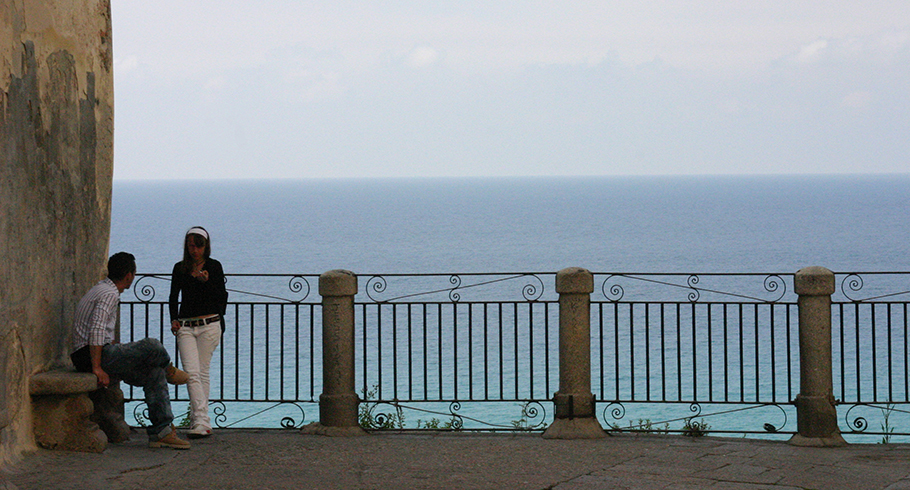THE ‘NEW’ RIJKS
A Personal Tour of the Rijksmuseum, Amsterdam
Part Two
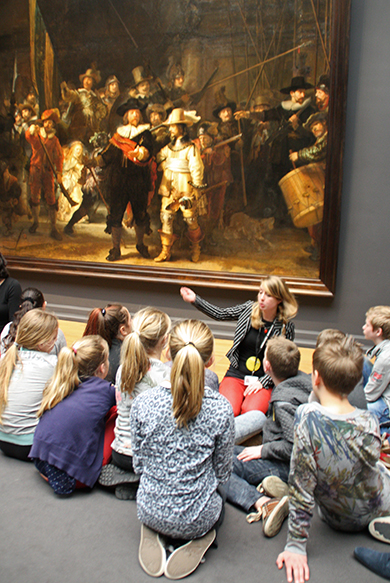
Front Hall
The recent restoration of the Rijks returned some of the attention to the building itself. So, it is also with renewed interest that one looks at the murals in the hall that precedes the so-called ‘Gallery of Honour’. For the Dutch visitor it is a test: ‘How (rusty) is my knowledge of our history?’
You see the guy that is about to jump off a tower and you know straight away you won’t get full marks. Although his last name is not as easy as his first, I remember his name all right. It is Jan van Schaffelaar, who had the courage to jump off a tower in pre-bungee jump times. But which tower? And when and where? (See below¹).
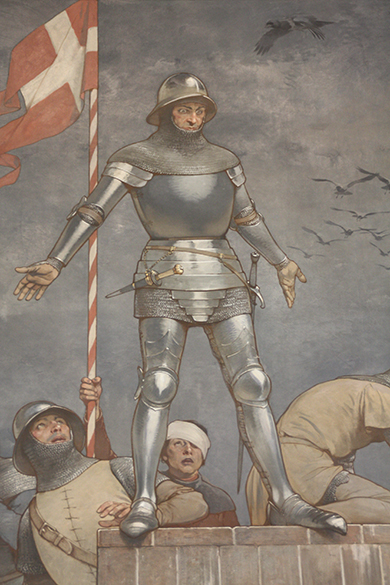
Also portrayed: William the Good². How good was he in actual fact? And so on. You would nearly forget that the stained glass windows behind you merit attention as well, in concert with the whole front hall falling victim to the tremendous suction force of The Nightwatch beyond.
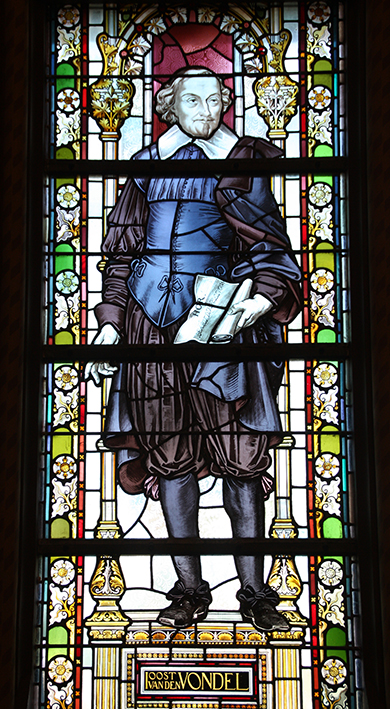
Famous Dutch writer (1587–1679)
Gallery of Honour
‘The Threatened Swan’ is still fresh on my mind ever since my first visit to the museum, decades ago. Only now I know it was the very first painting the Rijks ever bought. But all the same, now as then, I sense the same fascination for a slight detail: those swan droppings, just below the word ‘Raadpensionaris’ (grand pensionary). Could they be allegorical as well?
In the Dutch language ’to write it on the beam’ means something is really noteworthy. So, if your name is written on one of the beams of the Gallery of Honour, you must be in the Champions League. But, eh, Nicolaes Berchem, Jan de Heem, Paulus Moreelse and Philips Wouwerman?
‘Don’t you know them?!’, art lovers may now cry out in disbelief. Answer: ‘No’. And, frankly, when you discover their work a bit further down, you understand why they didn’t make it onto the walls of honour. Or were they there one day? Anyway, to make it anywhere into the Rijks is honourable in itself. Sure, it’s not that they’re bad. Take, for instance, Wouwerman’s ‘Grey Horse‘ and…
Cracking: the reading woman by Gerard Dou and the portrait of (maybe) Elisabeth Bas by (maybe) Ferdinand Bol. I promise them: from now on I will cycle more respectfully through the streets that carry their names.
N.B.
Often, to see the whole picture on the RIJKS-website you either have to pull up the image, click on the minus-sign or download the complete image.
That is especially important for ‘The Prayer without End’ by Nicolaas Maes. It can well serve as an example for failing to notice something that may have far reaching consequences. In this case bringing the prayer to an end after all. In short: you need to see the whole picture.
By the way, if the creature ‘little doggie’ had not yet existed, the Dutch painters would have invented it: for entertainment and to complete the composition. But the Rijks also has a big dog to offer in the lead role and one in the category Best Supporting Actor.
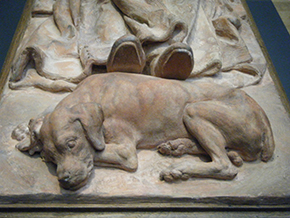
At the feet of William of Orange, ‘Father of the Dutch Nation’. Dead.
Concerning The Best Painting In The Rijks, I’ve never had a shred of doubt. The Chinese painter Chen Dehong with whom I once went to see it, he too was awestruck.
The most interesting aspect of The Nightwatch, by contrast, is the comparison with the small, but excellent copy beside it. It makes clear how much of the original was cut off and thrown away, only because the huge thing didn’t fit on the wall where it ended up after completion.
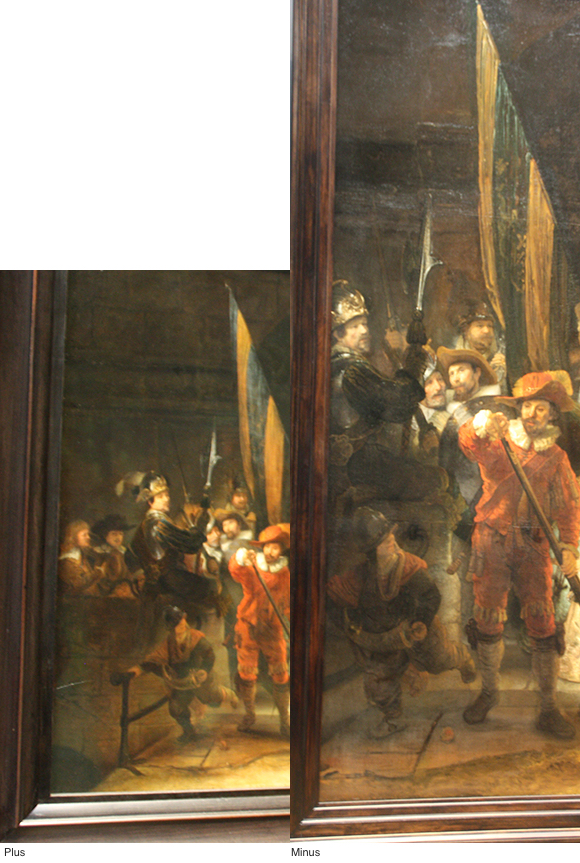
How good he is, good old Saenredam. A whole painting of a church (his specialty), mainly to show the detail that mattered to him most: the tombstone of his father. Again, to see it you must see the whole picture.
(And did he manage to paint that inscription without turning the canvas?)
A foreign visitor comes up with an interesting comment on the museum website. She laments that everything is so beautifully restored that it doesn’t really seem that old.
‘Some people can never be satisfied!’, one could counter, but all the same.
Maybe there’s some hope for her in the fact that a warden reveals that at times banquets are set up in the museum, even between the paintings. Not bad for the diners, gorging right next to gorging guild members from the Golden Age, but don’t all those dinner vapours have an ageing effect on what’s hanging on the walls?
1600-1650
2.1
Proof: there wás life before IKEA. Stern, but stunning.
Yes, they existed, Dutch ‘Caravaggists‘. But then mainly because ‘Cara’ preceded our ‘Remmy’, one hopes. Not long ago, an exhibition in Amsterdam was dedicated to those Big Two, to compare them.
‘And the (clear!) winner was…’
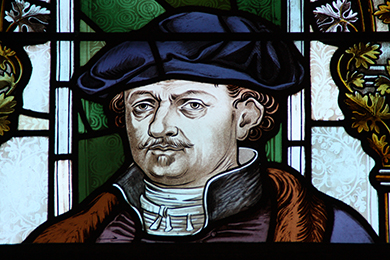
But I know an Italian, who… For his comfort: his idol is not forgotten, not even near the North Sea.
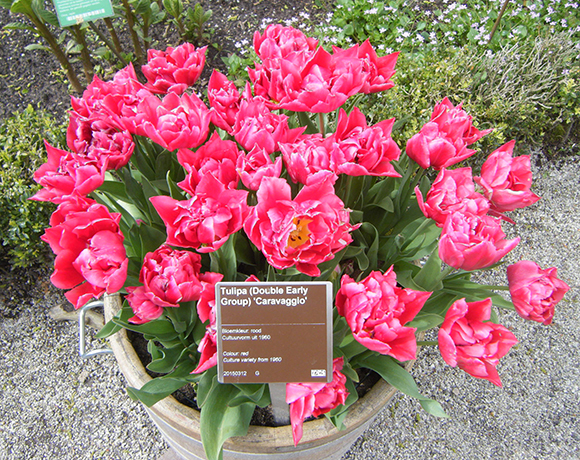
2.3
Ingenious object: balance with surprising counterweight.
2.5
‘Screaming Child, Stung by a Bee‘ is tremendously well-cut. So good, in fact, that this wooden head of a child doesn’t induce sympathy, as one might expect. As if you sense that the child isn’t just an innocent victim. On the contrary, you already tend to side with the bee even before you learn that the brat only got stung after stealing honey.
Besides, can it be true?! Is the maker of this wooden gem the very same Hendrick de Keyser who was the architect of important buildings? Answer: Yes.
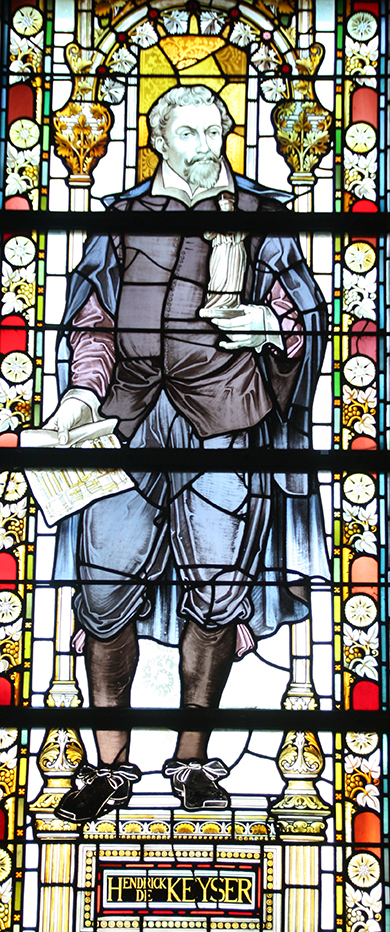
On the painting ‘Fishing for Souls‘, two groups can be seen… fishing for souls. On the left, the protestants, on the right the catholics. The painter clearly favours the protestant fishermen, but to what what extent should we conclude that he actually disapproves of the whole thing, by portraying it like this?
Hugo de Groot is one of those Dutchmen who were so famous that they became known also under latinized versions of their name. ‘Grotius’ was an eminent jurist who, among other things, wrote a treatise about ‘The Freedom of The Seas’, theoretically underpinning the Dutch desire to grab anything anywhere, making us rich.
Later in his career Grotius ended up imprisoned in a castle, out of which he escaped hidden in a book chest. So famous is this chest, that several ‘real’ versions survive today. How many, no idea. For sure, the Rijks has one of them.
Also: a portrait of a young, still beardless Hugo, looking like a predecessor of Mr.Bean.
2.6
Only this time I notice that in Avercamp’s ‘Enjoying the Ice‘ not everyone is joining the party. In fact, it takes a good look to discern them hanging there, in the freezing distance: figures dangling on the gallows. But in no way do they seem to spoil the fun.
In any case, humour is never far away on a true ‘Haenricus Av’. Thus, he signed his ‘Winter Landscape with Ice Skaters‘ with half-finished graffiti on a little shed. More than enough, of course, because any Avercamp is signed all over. In every skate and shitting arse, everything appearing very lively and well below zero at the same time.
Paulus van Vianen, silversmith, wrought the mythological Argus extremely well, in a way even that it makes you wonder whether he was in love with him. The naked, sleeping figure is caught in silver, just as he is about to be killed. After which his hundred eyes are transferred onto another creature one can show off with: the peacock.
It is one of the reasons why still lifes with peacocks are baffling today: they used to eat them.
2.8
Adriaan Pauw (Dutch for peacock) was Holland’s chief negotiator at the ‘Peace of Münster‘, that created in fact the ‘United Netherlands’. Therefore, that Peace-treaty is an integral part of the brain content of many of the Dutch, but it may serve as an example that you mainly see what concerns you directly. Few Dutch people know that the Peace of Münster is only a part of the far more encompassing Peace of Westphalia.
Another highly recommended ‘peace painting’ (and in general): Van der Helst.
Hm, can this one be a real Rembrandt? Okay, even he admittedly may have been young one day – No late Rembrandts without early ones – but all the same. Downright terrible: ‘Musical Company‘.
Anyway, with hindsight everyone wonders how anyone could ever have thought that ‘Supper at Emmaus’ by forgerer Han van Meegeren was a genuine Vermeer. Clearly, that work was not good enough. Still, the thumbs up of the ‘experts’ at the time managed to fool the public for a long time.
But maybe a dubious painting like Musical Company was really by Rembrandt’s hand and that it’s only because you don’t want to know The Great Master once wasn’t that masterly (yet), that you can’t believe it.
2.9
Nothing new, but incredible all the same: the Crown for the King of Ardra, a showy, but trumpery crown made of base metals. A gift of the English for an African ruler, to grease the (slave) trade.
N.B.
After leaving the last hall concerning the period 1600-1650, you would have to cross the Gallery of Honour again to continue with the first hall of the next period. By no means a form of punishment, but not very convenient. So, I passed through the next half of our Golden Age in the opposite direction. That’s why I can give the obedient a useful piece of advice:
1650-1700
2.15
When entering this hall, don’t forget to turn around!
Strikingly, the sign of the emergency exit sits right under the transom piece of the Royal Charles. What a trophy! Not only because of the size of it. This prize was won during one of the most daring naval exploits of the Dutch naval fleet. Maybe it could be better lit, but then maybe better not, in case it would make English visitors squeal.
Sure, Willem van de Velde The Elder is peerless. But the sails of some of the ships he portrays sport what seems to be an overdose of holes in them. For ships that are still afloat, that is. All the same, old Willem was the man who could know best. At the battle of Ter Heijde, for example, he was present himself.
2.16
From here, you can enjoy a splendid view down into the library. (Titles on Rembrandt: 856)
2.18
Funny: that a sculptor, commissioned to come up with something serious, can get away with a casual detail such as the mayor, fiddling with some frills.
Not funny: the abject lynching by the mob of the De Witt brothers an example of a painting that is much better known than its painter.
‘Like father, like son’. Just kidding. Was ’the rich kid‘ ever portrayed more strikingly?
2.19
Sad. You’ve painted a more than meritorious portrait, but on the information sheet about it they only dwell on the framing…
At times, though, the frame is indeed screaming to get the most attention:
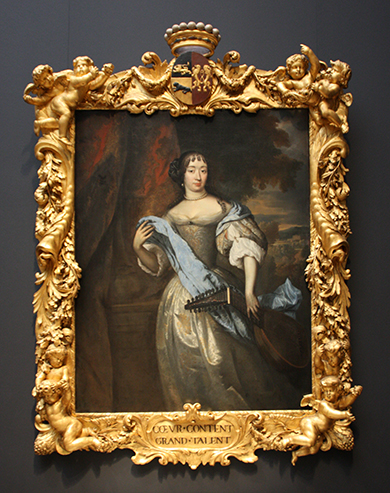
In other cases it is the caption that merits to be noticed:
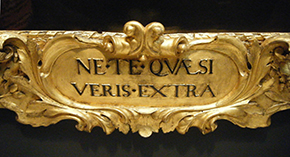
‘Seach for yourself not outside yourself’.
Quite a discovery (= an admission that I’m kind of late in doing so) is Artus Quellinus. And watching this couple, the idea of one’s ‘other half‘ becomes demonstrative.
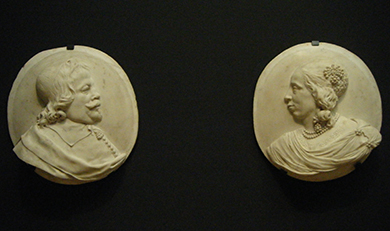
De Lairesse I’ve always known only because of the street that bears his name, in an upper-class neighborhood. His work proves to be on the kitschy side. So much so, that it makes you think: ‘Shouldn’t ‘his’ street better move to another part of town?’
2.22
Cabinets can hold ministers and what not. The one by Van Mekeren is admittedly somewhat crowded, but admirable all the same.
Hard to believe: this thing was apparently once seen as the pinnacle of Delft blue. Sold in 1876 for 1500 guilders! Today, one would say, at least I would: an absolute low in bad taste, that earthenware violin.
2.24
Quite a few still lifes are, in actual fact, rather noisy. Through the sheer abundance of what is lying still. But it can be stiller still.
Some studies are better to hang on your wall than the end result.
2.25
Clothes, painted by Ter Borch, are clothes you can hear…
2.26
If one would expect someone to boast an XXL-genital organ, then it must be Mars. But no. More M-ish, at most.
N.B.
What, in fact, is an L-size and what is M? I just read that 95% of men – no gods – make do with sizes between 6,5 and 11,5 centimetres. In pause.
Who, by the way, wants a tiny wooden skull in a tiny box. Not me, but wow, what craftmanship!
What does humanity owe to religion? The Rijks, for a start, would be much the poorer without it.
What does humanity owe to drink? The Rijks, for a start, would be much the poorer without it.
2.27
Sometimes, so-called ‘lesser’ painters turn out to be more major than that on second sight. Take Gerrit Houckgeest for instance.
The Golden Bend is the most expensive part of the Amsterdam canals. But what a sad sight they once were. Let’s say:
‘A canal without trees is like a woman without hair’.
*
¹ In fact, Jan’s story is a purely local one, dated the 16th of July, 1482. Afterwards, it was romanticized as an example of great courage. Cynics of today, though, may point to the fact that the only alternative would have ended with the same result. Jan found himself in a city under siege, with the attackers offering to spare his comrades if they would throw him down. An offer that inspired Jan to make a pre-emptive move…
² William I, Count of Hainaut. Not to be confused with William II of Sicily.
*
End of Part Two
*
© Joost Overhoff

